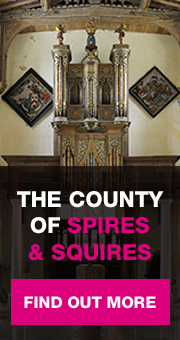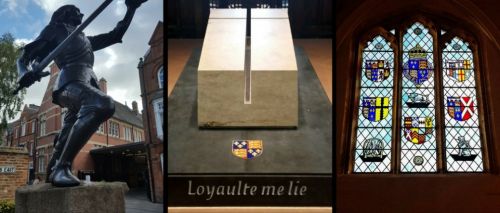14th March 2018
Historian Mike Ingram says Northamptonshire should stake its claim not just as the Rose of the Shires but also the Shire of the Roses…
In March 2015, all four of Northampton’s political parties committed themselves to a National War of the Roses Centre at Delapré Abbey in Northampton. Despite there being an award-winning Richard III visitor just up the M1 in Leicester, and the Bosworth Battlefield Centre, attracting thousands of visitors each year, nearly three years on, nothing has happened. There will be a 1460 Battle of Northampton exhibition at Delapré when it finally opens, but this will be too specific compared to what could and should be done.
Why is Northamptonshire that important and why should it have a National War of the Roses Centre? Because, Northamptonshire is at the very heart of the story of the Wars of the Roses. Not only were two of the key battles fought in the county but also Queen Elizabeth Woodville, wife of Edward IV and mother of the two princes who disappeared, came from Grafton Regis. She first met King Edward near Paulerspury and the two married in secret at Grafton, reportedly on 1 May 1464. Her brother Anthony, also born at Grafton and who became Lord Rivers after his father was executed in the aftermath the other Northamptonshire battle, Edgecote in 1469 (probably at Queen Eleanor’s Cross), was a renowned jouster. He was also the first patron of William Caxton who brought the first printing press to England and translated his first book for him.
And then there is Richard III, probably the county’s most famous son (although people could be excused today for thinking he came from Leicester). Richard Plantagenet was born on 2 October 1452, at Fotheringhay Castle in Northamptonshire, the twelfth of thirteen children and the fourth surviving son of Richard Plantagenet, duke of York, and Cecily Neville.
For the next few years, Richard lived predominantly at Fotheringhay with his brother George and sister Margaret, later called the diabolical duchess by king Henry VII. George, later Duke of Clarence would eventually be executed for treason by his elder brother, king Edward IV. Richard, George and Margaret would have also visited his elder brothers at Ludlow as well as Berkhamstead and Baynard’s castle in London. However, little is known of Richard’s formative years, although it is possible that he was destined for the church as he had a high level of learning which included Latin. Both Richard’s mother, Cecily Neville and father Richard, Duke of York are buried in tombs that can still be seen at Fotheringhay today. A small chapel and magnificent stained-glass window dedicated to Richard’s memory can also be seen in the church. Many of his other siblings who died during childhood are buried in now lost graves at Fotheringhay. Although most of the castle is now gone, the mound remains and is still an atmospheric reminder of what it once was.
DNA analysis of Richard’s remains suggests that the young Richard was likely to have had blue eyes and to have been born with blonde hair, although it probably darkened as he got older. Changes in carbon and nitrogen isotopes found in both his teeth and bones suggest he had a varied, protein rich diet which included large amounts of marine fish and seafood from around the age of three. These levels dropped off considerably around the age five, when family fortunes took a dramatic down turn. Analysis of oxygen and strontium in Richard’s tooth enamel also suggest that he lived at Fotheringhay until about the age of seven when he moved to be with his father and brothers at Ludlow.
When Edward IV died, the new King Edward V, and his guardian Anthony Woodville left Ludlow for London. Their party also included Sir Richard Grey, Sir Thomas Vaughan and 2000 men. Around the same time, Richard, then duke of Gloucester, left York with 600 ‘gentlemen of the north.’ It was planned that the two groups were to meet at Northampton. The Woodvilles’ who were travelling down Watling Street from Wales, stopped seventeen miles from Northampton at Stony Stratford, close to their powerbase and home at Grafton Regis. Then Rivers and possibly Grey, rode to Northampton to meet Richard on 29 April 1483. Richard would have felt safe at Northampton with its huge castle and town walls wide enough for six people to walk side by side. At some point, Richard was joined at Northampton by Henry Stafford, Duke of Buckingham and Earl of Northampton with three hundred men. Stafford was a descendant of Edward III through Thomas of Woodstock, his youngest son. His father had died of plague in 1458, and his grandfather was killed at the Battle of Northampton in 1460 where the five year old Henry was also knighted by Henry VI. In 1465, aged eleven he was created duke and the following year he was married to Katherine Woodville, Elizabeth Woodville’s sister, and probably lived at Grafton too, which according to contemporary writer Mancini, he highly resented. The Crowland Chronicle tells us that Rivers was “greeted with a particularly cheerful and merry face and, sitting at the Duke’s table for dinner, they passed the time in pleasant conversation.” at Northampton. However, the next morning Rivers lodgings in the town were surrounded by armed guards and he was arrested.
Richard and Buckingham then moved on to Stony Stratford where they dismissed Edward’s household and arrested Vaughan, Richard Haute (another Woodville relative and the controller of the household at Ludlow), along with Grey (if he had not already been arrested at Northampton). The contemporary writer Mancini claims that the Woodvilles were planning to assassinate Richard by preparing ambushes “both in the capital and on the road, which had been revealed to him by their accomplices.” He continued that “it was common knowledge that they had attempted to deprive him of the office of regent conferred on him by his brother.” Richard informed Prince Edward that he had uncovered a plot denying him the government, and that the perpetrators had been dealt with. He then took him back to Northampton, where they stayed until 3 May.
From there they went to London, and by September the new king had disappeared, and Richard was King of England. So, despite how important Northampton and Northamptonshire is to Richard III’s story, there is not one reminder anywhere (except Fotheringhay Church), despite the latest trend for statues of the more obscure or the ghost aps. How nice it would be to have a statue of him and or the uncrowned child King Edward V, even the Woodvilles, in the middle of the market square?
Historian Mike Ingram says Northamptonshire should stake its claim not just as the Rose of the Shires but also the Shire of the Roses…
In March 2015, all four of Northampton’s political parties committed themselves to a National War of the Roses Centre at Delapré Abbey in Northampton. Despite there being an award-winning Richard III visitor just up the M1 in Leicester, and the Bosworth Battlefield Centre, attracting thousands of visitors each year, nearly three years on, nothing has happened. There will be a 1460 Battle of Northampton exhibition at Delapré when it finally opens, but this will be too specific compared to what could and should be done.
Why is Northamptonshire that important and why should it have a National War of the Roses Centre? Because, Northamptonshire is at the very heart of the story of the Wars of the Roses. Not only were two of the key battles fought in the county but also Queen Elizabeth Woodville, wife of Edward IV and mother of the two princes who disappeared, came from Grafton Regis. She first met King Edward near Paulerspury and the two married in secret at Grafton, reportedly on 1 May 1464. Her brother Anthony, also born at Grafton and who became Lord Rivers after his father was executed in the aftermath the other Northamptonshire battle, Edgecote in 1469 (probably at Queen Eleanor’s Cross), was a renowned jouster. He was also the first patron of William Caxton who brought the first printing press to England and translated his first book for him.
And then there is Richard III, probably the county’s most famous son (although people could be excused today for thinking he came from Leicester). Richard Plantagenet was born on 2 October 1452, at Fotheringhay Castle in Northamptonshire, the twelfth of thirteen children and the fourth surviving son of Richard Plantagenet, duke of York, and Cecily Neville.
For the next few years, Richard lived predominantly at Fotheringhay with his brother George and sister Margaret, later called the diabolical duchess by king Henry VII. George, later Duke of Clarence would eventually be executed for treason by his elder brother, king Edward IV. Richard, George and Margaret would have also visited his elder brothers at Ludlow as well as Berkhamstead and Baynard’s castle in London. However, little is known of Richard’s formative years, although it is possible that he was destined for the church as he had a high level of learning which included Latin. Both Richard’s mother, Cecily Neville and father Richard, Duke of York are buried in tombs that can still be seen at Fotheringhay today. A small chapel and magnificent stained-glass window dedicated to Richard’s memory can also be seen in the church. Many of his other siblings who died during childhood are buried in now lost graves at Fotheringhay. Although most of the castle is now gone, the mound remains and is still an atmospheric reminder of what it once was.
DNA analysis of Richard’s remains suggests that the young Richard was likely to have had blue eyes and to have been born with blonde hair, although it probably darkened as he got older. Changes in carbon and nitrogen isotopes found in both his teeth and bones suggest he had a varied, protein rich diet which included large amounts of marine fish and seafood from around the age of three. These levels dropped off considerably around the age five, when family fortunes took a dramatic down turn. Analysis of oxygen and strontium in Richard’s tooth enamel also suggest that he lived at Fotheringhay until about the age of seven when he moved to be with his father and brothers at Ludlow.
When Edward IV died, the new King Edward V, and his guardian Anthony Woodville left Ludlow for London. Their party also included Sir Richard Grey, Sir Thomas Vaughan and 2000 men. Around the same time, Richard, then duke of Gloucester, left York with 600 ‘gentlemen of the north.’ It was planned that the two groups were to meet at Northampton. The Woodvilles’ who were travelling down Watling Street from Wales, stopped seventeen miles from Northampton at Stony Stratford, close to their powerbase and home at Grafton Regis. Then Rivers and possibly Grey, rode to Northampton to meet Richard on 29 April 1483. Richard would have felt safe at Northampton with its huge castle and town walls wide enough for six people to walk side by side. At some point, Richard was joined at Northampton by Henry Stafford, Duke of Buckingham and Earl of Northampton with three hundred men. Stafford was a descendant of Edward III through Thomas of Woodstock, his youngest son. His father had died of plague in 1458, and his grandfather was killed at the Battle of Northampton in 1460 where the five year old Henry was also knighted by Henry VI. In 1465, aged eleven he was created duke and the following year he was married to Katherine Woodville, Elizabeth Woodville’s sister, and probably lived at Grafton too, which according to contemporary writer Mancini, he highly resented. The Crowland Chronicle tells us that Rivers was “greeted with a particularly cheerful and merry face and, sitting at the Duke’s table for dinner, they passed the time in pleasant conversation.” at Northampton. However, the next morning Rivers lodgings in the town were surrounded by armed guards and he was arrested.
Richard and Buckingham then moved on to Stony Stratford where they dismissed Edward’s household and arrested Vaughan, Richard Haute (another Woodville relative and the controller of the household at Ludlow), along with Grey (if he had not already been arrested at Northampton). The contemporary writer Mancini claims that the Woodvilles were planning to assassinate Richard by preparing ambushes “both in the capital and on the road, which had been revealed to him by their accomplices.” He continued that “it was common knowledge that they had attempted to deprive him of the office of regent conferred on him by his brother.” Richard informed Prince Edward that he had uncovered a plot denying him the government, and that the perpetrators had been dealt with. He then took him back to Northampton, where they stayed until 3 May.
From there they went to London, and by September the new king had disappeared, and Richard was King of England. So, despite how important Northampton and Northamptonshire is to Richard III’s story, there is not one reminder anywhere (except Fotheringhay Church), despite the latest trend for statues of the more obscure or the ghost aps. How nice it would be to have a statue of him and or the uncrowned child King Edward V, even the Woodvilles, in the middle of the market square?
The Richard III connections do not end there. Two of Richard’s leading supporters were William Catesby and Lord John Lovell, both immortalised in the ditty by Collingbourne that was pinned to the door of St. Pauls in London:
The Catte (Catesby), the Rat (Ratcliffe) and Lovell the dog,
Rule all England under the hog (Richard)
William Catesby was an ancestor of Robert Catesby who led the Gunpowder Plot. He was the son of Sir William Catesby of Ashby St Ledgers, Northamptonshire and Philippa, daughter and heiress of Sir William Bishopston. His father was Sheriff of Northamptonshire in 1442-3 and 1451-2, and sometime before May 1453, was made an Esquire of the Body to Henry VI. William junior was trained for the law in the Inner Temple and we first hear of him as ‘W. Catysby, lectorem,’ discoursing on the nature of the Magna Carta. As an aspiring lawyer, Catesby initially progressed in the service of William, Lord Hastings but acted for many others too. He married Margaret, daughter of William La Zouche, 6th Baron Zouche of Harringworth in Northamptonshire, and the couple would go on to have had three sons. Upon the death of his father, Catesby inherited a large number of estates in the Midlands. These included Welton, Harlestone and Heyford, Watford, Creaton, Hinton, Braunston, Ashby, Stanford, Stormsworth, and Yelvertoft, Hellidon and Hinton all in Northamptonshire. He was also land-agent for many others. It is probable that William Catesby junior sat as knight of the shire for Northamptonshire in Edward IV’s last parliament in 1482, and where his uncle, John Catesby of Whiston in Northants was knighted. He had already come to Richard’s attention before 14 May 1483 when he was granted for life the office of Chancellor of the Earldom of March. Following Hastings’ execution, Catesby was made Chancellor of the Exchequer, Chamberlain of the Receipts and Constable of the Castle and Master Forester of Rockingham, as well as being named steward of certain Crown lands in Northamptonshire. All were offices previously held by Hastings. Richard then made Catesby, an esquire of the Body and a full member of his Council.
At the Battle of Bosworth which was fought on 22 August 1485 and where Richard was killed, Catesby however, was captured and the only noble to be executed by the new king, Henry VII at Leicester. His monumental tomb which he shares with his wife lies in Ashby St. Ledger.
The manor of Titchmarsh first came to the Lovell family in 1244, when John Lovell II married Maud de Sydenham. John Lovell III received a licence to crenellate his manor house at Titchmarsh in 1304, however, by 1361 it was already in a state of disrepair. John Lovell V had two sons who were both called John. John Lovell VI died in 1363 still underage. His younger brother, John Lovell VII, restored the family’s fortunes. John Lovell VII was also heavily involved in with the royal court. He began his ‘career’ as a courtier in the last years of Edward III’s reign, was first summoned to parliament in 1375, and continued to be involved at the centre of government until shortly before his death in 1408.
He married Maud Holland, granddaughter and heiress of Robert Holland, whose younger brother was the first husband of Joan of Kent, who later married Edward ‘the Black Prince’. To commemorate this union, John Lovell VII not only used as his coat-of-arms, the Lovell arms quartered with the Holland arms but also by styling himself ‘Lord Lovell and Lord Holland‘ and built a new castle at Wardour. Francis was the son of John Lovell, 8th Baron Lovell of Titchmarsh and Joan Beaumont, daughter of John Beaumont, 1st Viscount Beaumont, who was killed at the 1460 battle of Northampton. When his father died he became a ward of Richard Neville, the Kingmaker, where his close association Richard started.
In 1466, he married Anne FitzHugh, daughter of Henry FitzHugh, 5th Baron FitzHugh. Fitz Hugh had married the Kingmakers sister Alice Neville, who is best known for being the great-grandmother of Queen Catherine Parr and was buried at Greyfriars in Northampton. When Edward IV had re-established his rule in 1471, he granted the wardship of Francis Lovell, who was still underage, to his sister Elizabeth and her husband John de la Pole, 2nd Duke of Suffolk, where he also started his long association with the de la Poles, who would be declared by Richard III to be his heirs. Lovell served under Richard in the expedition to Scotland in 1480, and was knighted by Richard, the same year. He was created a viscount on 4 January 1483. When Richard took the crown, Lovell was promoted to Lord Chamberlain, and was made a Knight of the Garter. He was one of the wealthiest barons in England not holding an earldom or dukedom
Lovell took part in the Battle of Bosworth on Richard’s side. Afterwards, he spent a considerable time in hiding and tried, unsuccessfully, to kidnap Henry VII at York in the spring of 1486. In the following year he was among those who supported the rising in favour of Lambert Simnel. Francis Lovell fought at the battle of Stoke but went missing afterwards. Some say he was walled up inside his home at Minster Lovell only to be forgotten, so died of starvation, others that he escaped to Scotland.
When Richard came to Northampton in 1483, Roger, son of Thomas Wake VI was Sheriff of Northamptonshire for the second time. Aged 24, he inherited Blisworth in 1476 and was also married to William Catesby’s sister, Elizabeth. Roger fought with Richard III and his brother-in-law Catesby at Bosworth. His lands were confiscated by Henry VII for his part in the battle, but were later restored to him. His and his wife’s magnificent tomb can still be seen in Blisworth Church today. Before him, there were six generations of Thomas Wakes all of whom owned Blisworth. The first Sir Thomas Wake was a distinguished soldier and had married Elizabeth Cransley from Kettering. He was a Knight of the County, the Kings Chief Falconer, Sheriff in 1329 and again in 1335. He took 200 Archers from the county to France in 1345 and fought with the Black Prince, son of King Edward III at Crecy. He died young in 1346 during the Siege of Calais. Thomas Wake V, was known as The Great Wake and controlled a huge number of manors including Blisworth, Collingtree and Milton Malsor as well as manors in Lincolnshire, Buckinghamshire, Bedfordshire and Kent.
Thomas Wake VI was born in 1435, and inherited aged 23. He was Sheriff on two occasions in 1461 and 1463. He married Elizabeth Beauchamp, a daughter of the Earl of Warwick who was 20 years older than him. This Thomas was a Commissioner of Array for Northampton and took part in the 1460 Battle of Northampton on the Lancastrian side. By July the following year, he had changed sides and was supporting the Yorkists. In July 1461, he was on a commission to take the possessions of Sir Thomas Thorpe and Sir Thomas Tresham into the King’s hands. In 1469, whilst Thomas was Sheriff of Northampton, he accused the Queen’s mother, Jacquetta of Luxembourg of witchcraft.
And that is just the Yorkists!
Next month we will look at Northamptonshire’s Lancastrians and what happened to them.
Reference: NeneQuirer
Your login details have been used by another user or machine. Login details can only be used once at any one time so you have therefore automatically been logged out. Please contact your sites administrator if you believe this other user or machine has unauthorised access.








